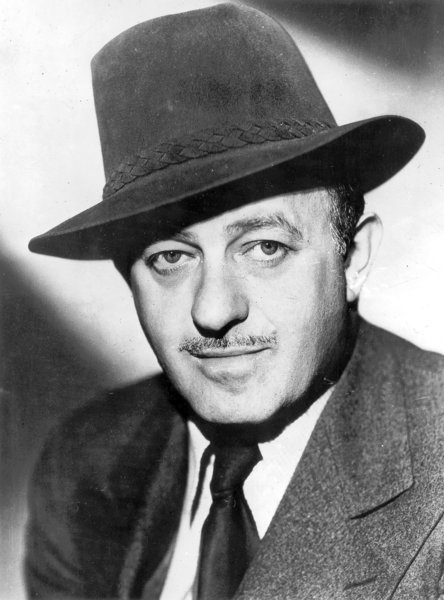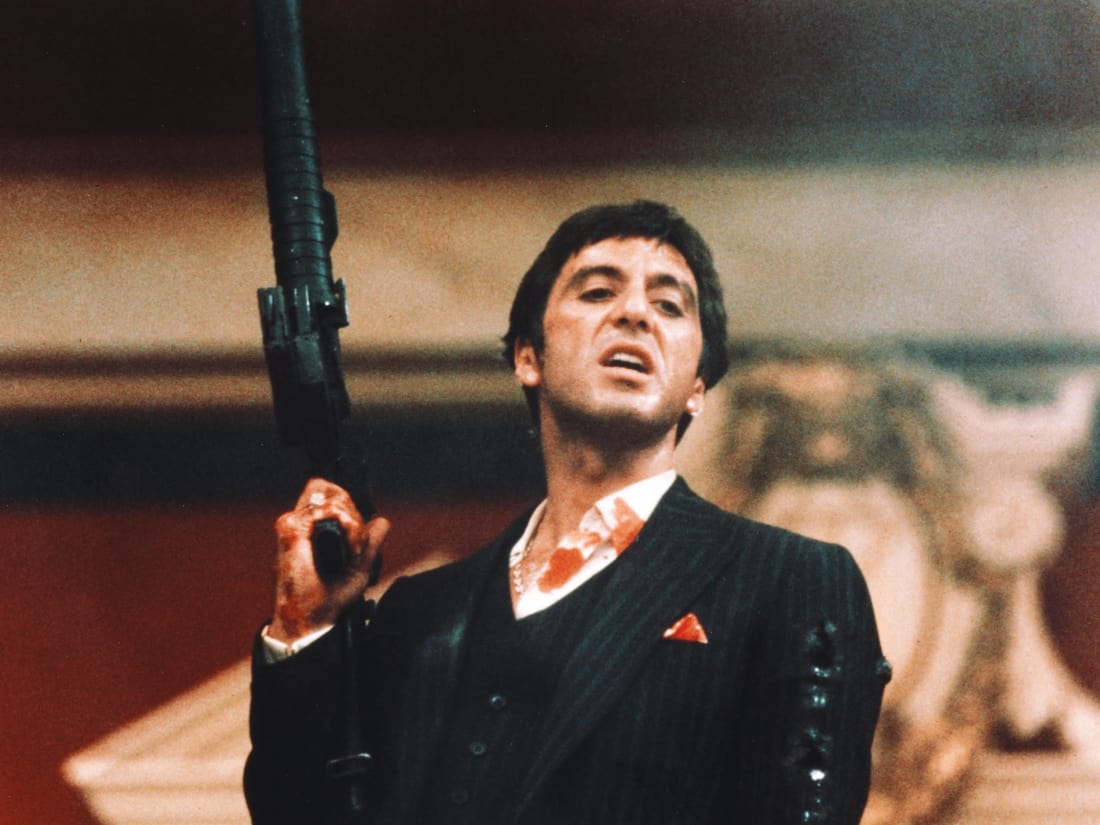When most people usually hear the title "Scarface", immediately what comes to mind is the 1983 gangster film directed by Brian De Palma starring Al Pacino. And it's easy to understand why given what a popular pop culture phenomenon it is with modern day viewers thanks to its visual style, quotable dialogue (the most quoted line being "Say hello to my little friend"), Al Pacino's memorable performance as Tony Montana, and its controversial violence and constant swearing. However, given that the film is so widely recognized, many people tend to overlook the fact that the film is a remake of an already successful gangster film of the same name back in 1932 that was considered to be just as controversially violent.

WARNING: THERE WILL BE SPOILERS!

WARNING: THERE WILL BE SPOILERS!
The 1932 "Scarface" tells the story of the rise and fall of the Italian immigrant gangster Tony Camonte (played by Paul Muni) who joins forces with mob boss Johnny Lovo to help smuggle alcohol in the South Side of Chicago during Prohibition, as they fight against their rivals on the North Side. However, as Tony moves up in the business, he begins to make some moves of his own that are against his boss' wishes, while also hitting on Johnny's girlfriend Poppy. When Tony goes too far, in spite of his success of rubbing out their rivals on the North Side and making more money on illegal liquor, a jealous and outraged Johnny orders a hit on Tony, but he luckily comes out alive, and has his boss killed as an act of revenge and his final step to reaching to complete power. But Tony's enjoyment for reaching to the top doesn't last for long. When he discovers that his sister Cesca is dating his best friend and partner in crime Guino (played by a young George Raft), he kills him out of jealousy for his incestuous feelings towards her, resulting with Cesca reporting this crime to the authorities that ends with Tony fighting against the cop in his apartment and eventually winding up dead during the shootout.

Gangster films were already considered to be a hit during the early 30s thanks to the success of films such as "Little Caesar" starring Edward G. Robinson, and "The Public Enemy" starring James Cagney, which caused screenwriter Ben Hecht to write an adaptation of a novel to film producer Howard Hughes and the film's director Howard Hawks. Considering that the film would not only be depicting the criminal activity that was going on with the mob at the time through the perspective of a criminal, but has also based the character on the real-life gangster (who was still in power at the time) Al Capone, as the film would recreate half of the crimes he's committed on the big screen (the most notable one being "The St. Valentine's Day Massacre") controversy from Capone's mob and the censors would arise to the people behind this film to prevent it from being released. Two of Capone’s associates approached Hecht to intimidate him about doing a film loosely based on their boss, but since Hecht was once a tough Chicago newspaper journalist, he wasn't intimidated by the thugs and was able to convince them to be consultants for the movie.

To Hecht, Hughes, and Hawks, Capone's thugs were nothing when compared to the powerful film censorship board the Hays Office. When the Hays Office saw the film, they found the film to be so violent and feeling that the film was glorifying the gangsters than it was dishonoring them that they demanded a large number of changes toward the picture in order for it to be released to the public. This forced the filmmakers to tame the violence. Put an opening scroll at the beginning of the film to inform audiences that the film isn't supposed to glorify gangster. Subtitle the film as "Shame of a Nation" instead of just calling it "Scarface". Shoot new scenes involving the press and the police discussing how gangsters are destroying America. And above all, demanded an alternate ending of Tony (this time played by a stand-in for Muni after refusing to do the scene) being hanged, since him being gunned down was demeaned to be too violent of a demise. When the censors took a look at the sanitized version of the film, they still weren't satisfied! After the amount of frustration of trying to screen the film, the film with its original ending was eventually distributed to states that had the desire to screen the film. Upon its release, the film became a hit with critics and audiences at the time. And Al Capone who was so skeptical about the film being loosely based off him loved the film so much that he would show his own print of the film to his friends and write a letter to Howard Hughes thanking him for the mythology.

As time went on, the art of film gradually changed, and the Hays Code that heavily censored films since the 1930s was lifted in 1965. By the late 1960s, films would take a much more risqué turn by having nudity, making the violence appear to be more grotesque, and adding swear words. And throughout the 1970s, gangsters films like "Mean Streets", "The Godfather", and "The Godfather Part II" would set a new-bar for film-making and be mimicked up to the very present. While films began to change, so did the real-life tough guys. When Prohibition was over and that everybody can now have legal access to alcohol, gangsters were seeking new ways to make money through the use of illegal products. They still made tons of money off of loansharking, prostitution, and gambling (especially through their Casinos in Las Vegas), but when the narcotics trade came into play, it heightened the risks for the mobsters where they'd be facing more years of prison than from any of their other illegal trades, but they would be making double the money that they're currently making. When Hollywood Producer Martin Bregman watched the 1932 "Scarface" on TV late at night when he couldn't sleep, he had an idea to remake the film. However, instead of setting the film back during the 20s, director Sidney Lumet (who later turned down directing the film after showing displeasure with the final script) gave Bregman the idea to set it in modern times.

The 1983 remake of "Scarface" has the same story elements that the original film had, such as an immigrant who rises to power by distributing illegal goods and killing his boss, to slowly falling from power and getting killed in the end during a massive shoot-out. And the relationships that Montana has with his boss, love interest, best friend, and sister are nearly as identical as Camonte's relationship with the characters from the 1932 classic. The only major changes mostly come from adapting this classic gangster story to fit within the film's modern setting. Rather than Tony being an Italian immigrant living in Chicago, Lumet thought it would be more fitting to have Tony be a Cuban immigrant from the Mariel Boat Lift that brought the Cuban refugees to Miami Florida in the early 80s, since many of those refugees turned to a life of crime to achieve the American dream just like the immigrants during the turn of the century. And given how criminals in Miami Florida were selling drugs to make big money, Lumet felt that it would be a perfect substitute for alcohol.


Unlike the original, the remake wasn't based on any particular gangster, but most of the killings and how these characters organize their business was indeed loosely based on actual events. To give an accurate depiction of the cocaine world that was happening in Florida at the time, scriptwriter Oliver Stone interviewed attorney generals, lawyers, and ex-gangsters; and was granted access to criminal records (files, audio tapes, and videos of crime scenes) in places like the county of Miami, the Dade County, and Fort Lauderdale. Seeing all these files and hearing about what these criminals did to each other (like slicing each other up with a chainsaw instead of just putting in a bullet through their bodies) fascinated Stone so much that he was determined to learn more. While on vacation, Stone decided to visit countries like Ecuador and Bolivia to interview drug-kingpins who lived in big mansions and would wear lots of jewelry and flashy suits. These playboy figures were flattered to have their business and lifestyle be brought to the big screen and welcomed Stone to their homes. However, after getting high on the cocaine that Oliver Stone was offered, he mentioned one of the law enforcement officials that he had interviewed in Miami, and as soon as they heard the name of the authority figure he spoke with, their friendly faces dropped and began to suspect that he was an undercover cop posing as a filmmaker. Unlike how Ben Hecht negotiated with the thugs that threatened him, Stone did the opposite by heading back to America as quickly as possible.


Anybody who's seen the remake of "Scarface" will talk about how incredibly violent and vulgar the film is, and though there have been gangster films during this new era of filmmaking that had its share of blood and profanity, they didn't cross as many lines when compared to this flick. Gangster films before this film pretty much just had gun-fire, strangling’s, and moments where they would hit each other. But the new "Scarface" offered more than those kinds of violent elements that audiences would see in a gangster film. It had a guy being butchered by a chainsaw. A mafia man being hung from a flying helicopter. Numerous scenes of the characters excessively snorting cocaine. And more foul language and the constant use of the four-letter F-word than what any other mafia film before this film could get away with. Its extreme mature content was considered too much for the MPPA that they originally stamped the film with an X rating. Upon receiving such a high rating that would prevent many audiences from viewing the picture, the film's director Brian De Palma cut the film three times to please the censors. But every single time he handed in each of his cuts, the MPPA was still just as displeased with its graphic content as the Hays Office were with the original "Scarface". Refusing to cut any more scenes out feeling the film would at that point lose its dramatic thrust; De Palma called a few of his reporter friends to write numerous articles about the trouble the film was having with the censors. Bregman himself even fought against this outrage during a court case against the MPPA, where he brought in the head of Time magazine, the head of the Organized Crime Bureau of Miami, and three psychiatrists explaining how the film wouldn't affect the children for being an anti-drug movie and how important it is to release this film to a wider audience to inform them of what's happening in the cocaine world. Bregman won the case by a vote that was 18 to 2 in favor of granting this film an R rating, and when De Palma realized that his other cuts were given the same X rating as his edited version, he went ahead and released the original cut of his movie. The film wasn't an instant hit with critics at the time, but its legacy would continue to grow as the years went by.
Both the original and the remake of "Scarface" are in many ways alike from its story and controversy with the censors. But they're in many ways different for how each one reflects the time of film-making and organized crime. It’s needless to say that the version that's more popular with modern day audiences that even still continues to shock people with its violence, is the remake. But the legacy of the original will not only be lived on through its superior remake but also from film scholars and historians who remind us of the evolution of film. These two films are indeed pure examples of how far we've come from in film-making, and how the mafia is only getting worse as time goes on.
No comments:
Post a Comment